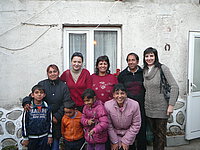Unraveling the molecular basis of hereditary spastic paraplegias –
Contribution from European Gypsies
Prof. Albena Jordanova, PhD
Molecular Neurogenomics Group, VIB Department of Molecular Genetics,
University of Antwerp, Belgium
Molecular Medicine Center, Department of Medical Chemistry and Biochemistry,
Sofia Medical University, Sofia, Bulgaria
1. Synopsis of proposed activities
Hereditary spastic paraplegias (HSP) are a group of rare neurodegenerative disorders of the upper motor neurons characterized by extreme clinical and genetic heterogeneity. The HSP disease is currently untreatable and poorly understood, warranting research on its etiology and potential targets for intervention. We aim at clarifying the biological complexity underlying this condition focusing on the identification of novel genes and disease-causing mutations involved in HSP pathogenesis. Our special "research tool" will be the unique genetic heritage of Gypsies (Romas) - the largest genetic and socio-cultural isolate of Europe. Referred to as ''the invisible minority'', Gypsies are an indispensible part of the social and cultural landscape of modern Europe. Research on HSP in this unique founder population provides a substantial and yet unexplored potential, as limited genetic diversity, large traditional families and shared ancestral mutations could simplify the etiological complexity of this disease.
We propose to conduct a study on the molecular basis of HSP, taking advantage of our unique collection of Gypsy patients with this disorder. We will apply an approach of simultaneous genetic search for several trait-causing loci that will allow identification of novel loci, genes and disease-causing mutations, respecting at the same time the genetic heterogeneity of HSP. We have extended genealogical and clinical information and genetic material of 18 Gypsy familial and sporadic cases, with excluded mutations in the spastin and paraplegin genes.Considering the trans-national nature of the Roma isolate, additional families will be collected trough established collaborations with neurologists and geneticists across Europe. We will pursue four objectives: (i) Large scale SNP genotyping to search simultaneously for several trait-causing loci using homozygosity mapping (in HSP families with recessive inheritance) and linkage analysis (in cases with both dominant and recessive inheritance). Our disease model ideally suits this genetic approach, since the rarer the disease form, the more pronounced the homozygozity effect. (ii) Patients linked to already known loci and genes will be further analysed to identify the disease-causing mutations. (iii) Patients linked to unknown loci will be further compared to identify overlapping HSP-associated regions and shared haplotypes. Subsequently, (iv) whole exome/genome sequencing in selected individuals, (v) hit validation in patient cohorts from Gypsy and outbreed communities, and (vi) functional genomics approaches will allow identification of novel HSP genes. Considering our preliminary data for genetic heterogeneity of HSP in this community, the structure of available families and our approach, we envisage identifying more than one novel HSP gene.
Our research will reveal novel molecular players and pathways underlying HSP, increasing the basic knowledge on their pathology and providing avenues for development of new therapeutic strategies. The results of this study should contribute to identification of novel genetic entities and to a catalogue of genes and disease-causing genetic variants causing HSP that can subsequently be genotyped in large outbreed populations. Thus, this project is of more than a local significance since its finding will be of general relevance for the research field and will be applicable to all national health care systems. The mutation identification will allow genotype-phenotype correlations and will have an important impact on the diagnostic of spastic paraplegias, genetic counseling and disease prevention.




